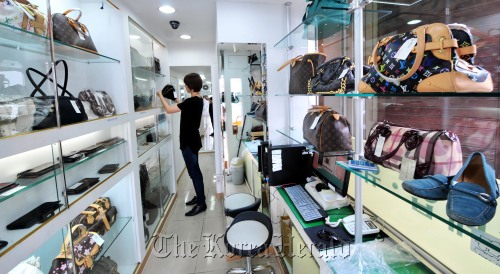Koreans’ love for labels keeps used-goods industry bustling
Kim Hae-mi had been more than a little doubtful as to whether it was a good idea to pick out the first Chanel bag of her life from a second-hand store.
She recalled how unenthusiastic she was when she made the trip to Myeong-dong, a popular local shopping district in downtown Seoul dotted with the second-hand and consignment shops.
But she also had a limited budget and knew the bags cost an arm and a leg at department stores; Kim ended up buying one of the classic Chanel totes for 2 million won ($1,800) bag as a birthday gift to herself.
“I really thought there was nothing doing when I first went, but after I saw the prices and the guarantee that everything was the real McCoy, I decided this is not a bad deal,” Kim said.
Her “new” bag showed a bit of wear and tear, but hey, Kim said, a Chanel bag for half the price of a new one can’t be all bad, especially since brands like Chanel never go out of vogue.
The 29-year-old is one of the many Koreans who live in a country that seems to never tire of designer brands.
Over the past five years, Louis Vuitton Korea’s sales soared almost three-fold to 427.3 billion won, according to Financial Supervisory Service figures.
Gucci, another beloved brand, said their sales have almost doubled since 2006, meaning Koreans were snapping up their favorite designer brands even though the world ― and the country ― was struggling to shrug off an economic downturn.
Along with China and Russia, Korea still holds its own as a one of the world’s biggest markets for designer brand goods, industry watchers said.
The decade-old industry is this year expected to ring up more than 1 trillion won of revenues, they added.
In almost all parts of Korea, shops flaunting used designer goods are tucked away in the hearts of the hottest shopping districts.
In Myeong-dong, second-hand stores line the tiny alleys connected to the main strip.
 |
An employee of a second-hand store in Myeong-dong, downtown Seoul, sets products in order Thursday. (Kim Myung-sub/The Korea Herald) |
Household names like Koibito and Gugus ring a bell with most customers who are familiar with second-hands goods.
Koibito, for instance, is one of the oldest in the industry and registers daily sales of several million won.
Others, such as Mienne, are new to the neighborhood, but they believe the market is far from being saturated.
“We’re the new kid on the block, but we are seeing a steady stream of people who want to buy and sell from us, so it’s not going to be too long before we take,” said Choi Min-hye, manager of Mienne.
The online second market is also bustling, with sites like feelway.com establishing itself as the place to go for safe and secure designer brand shopping.
The merchandise runs the gamut from clothes, shoes and bags to smaller accessories like wallets, watches and even jewelry.
One surprise about these second-hands is that they are far from cheap, per se.
Kim Hae-mi said she forked over almost two-grand for her Chanel bag, but some cost five times as much.
The price tag for the coveted Hermes Birkin bag 35, for instance, was 8 million won, which is about $7,000.
The price actually does not go down too far from the original price of somewhere between 10 million won and 15 million won. The crocodile hide bag costs more than 30 million won.
“There’s a huge demand for the more exclusive goods, which are hard to get at department stores or duty free because they just fly right off the shelves,” said a sales person at Koibito. “So they come to us.”
It’s also this undying demand that keeps the second-hand business afloat.
People with bags or other used items they tired of but have tighter budgets head to these shops to sell or trade in their merchandise.
“Some of these people are looking for quick cash, but mostly, it’s about fashion-conscious consumers looking for more variety in their closets,” said Choi of Mienne.
The shops also sell by consignment, receiving an average 18 percent commission.
As for concerns about the authenticity of the merchandise, Choi said it would be impossible to stay in the business if they sold fake or stolen goods.
A sign at the front of the store promises a “200 percent refund” to anyone who bought anything fake.
At Koibito, a list of the number of police stations in the area, along with the direct hotline for reporting stolen goods is conspicuously displayed on the counter.
But due to the growing number of customers duped by online scams, shops now take more time ― up to several days ― to check the items before paying up.
Choi noted that these days, it’s not only Koreans but foreigners ― mostly Asian such as Japanese and Chinese shoppers ― who drop by to browse and make the occasional purchase.
“They make up just a fraction of the consumers, but I do see a bigger number of foreign shoppers,” she said.
By Kim Ji-hyun (
jemmie@heraldcorp.com)





![[Exclusive] Hyundai Mobis eyes closer ties with BYD](http://res.heraldm.com/phpwas/restmb_idxmake.php?idx=644&simg=/content/image/2024/11/25/20241125050044_0.jpg)
![[Herald Review] 'Gangnam B-Side' combines social realism with masterful suspense, performance](http://res.heraldm.com/phpwas/restmb_idxmake.php?idx=644&simg=/content/image/2024/11/25/20241125050072_0.jpg)

